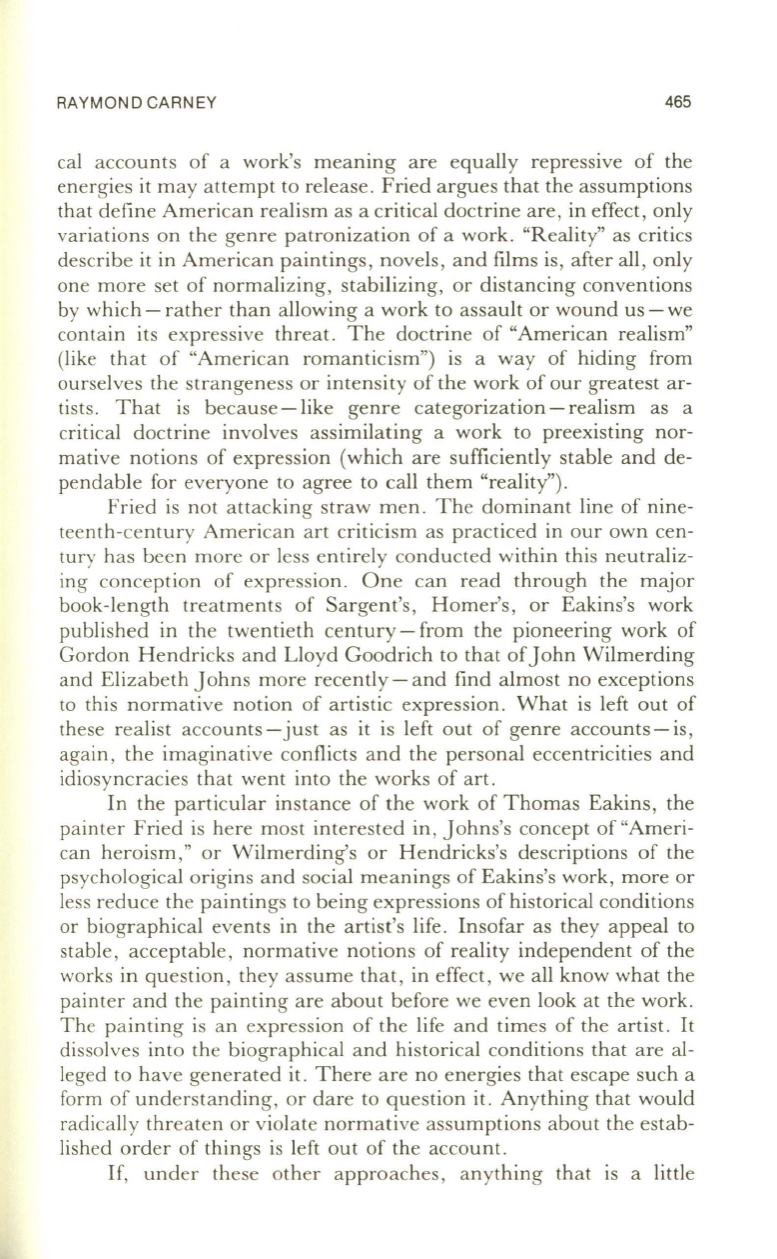
RAYMOND CARNEY
465
cal accounts of a work's meaning are equally repressive of the
energies it may attempt to release. Fried argues that the assumptions
that define American realism as a critical doctrine are, in effect, only
variations on the genre patronization of a work. "Reality" as critics
describe it in American paintings, novels, and films is, after all, only
one more set of normalizing, stabilizing, or distancing conventions
by which - rather than allowing a work to assault or wound us - we
contain its expressive threat. The doctrine of "American realism"
(like that of "American romanticism") is a way of hiding from
ourselves the strangeness or intensity of the work of our greatest ar–
tists. That is because -like genre categorization - realism as a
critical doctrine involves assimilating a work to preexisting nor–
mative notions of expression (which are sufficiently stable and de–
pendable for everyone to agree to call them "reality").
Fried is not attacking straw men . The dominant line of nine–
teenth-century American art criticism as practiced in our own cen–
tury has been more or less entirely conducted within this neutraliz–
ing conception of expression. One can read through the major
book-length treatments of Sargent's, Homer's, or Eakins's work
published in the twentieth century - from the pioneering work of
Gordon Hendricks and Lloyd Goodrich to that of John Wilmerding
and Elizabeth Johns more recently - and find almost no exceptions
to this normative notion of artistic expression. What is left out of
these realist accounts - just as it is left out of genre accounts - is,
again, the imaginative conflicts and the personal eccentricities and
idiosyncracies that went into the works of art.
In the particular instance of the work of Thomas Eakins, the
painter Fried is here most interested in, Johns's concept of "Ameri–
can heroism," or Wilmerding's or Hendricks's descriptions of the
psychological origins and social meanings of Eakins's work, more or
less reduce the paintings to being expressions of historical conditions
or biographical events in the artist's life. Insofar as they appeal to
stable, acceptable, normative notions of reality independent of the
works in question, they assume that, in effect, we all know what the
painter and the painting are about before we even look at the work.
The painting is an expression of the life and times of the artist. It
dissolves into the biographical and historical conditions that are al–
leged to have generated it. There are no energies that escape such a
form of understanding, or dare to question it. Anything that would
radically threaten or violate normative assumptions about the estab–
lished order of things is left out of the account.
If,
under these other approaches, anything that is a little


